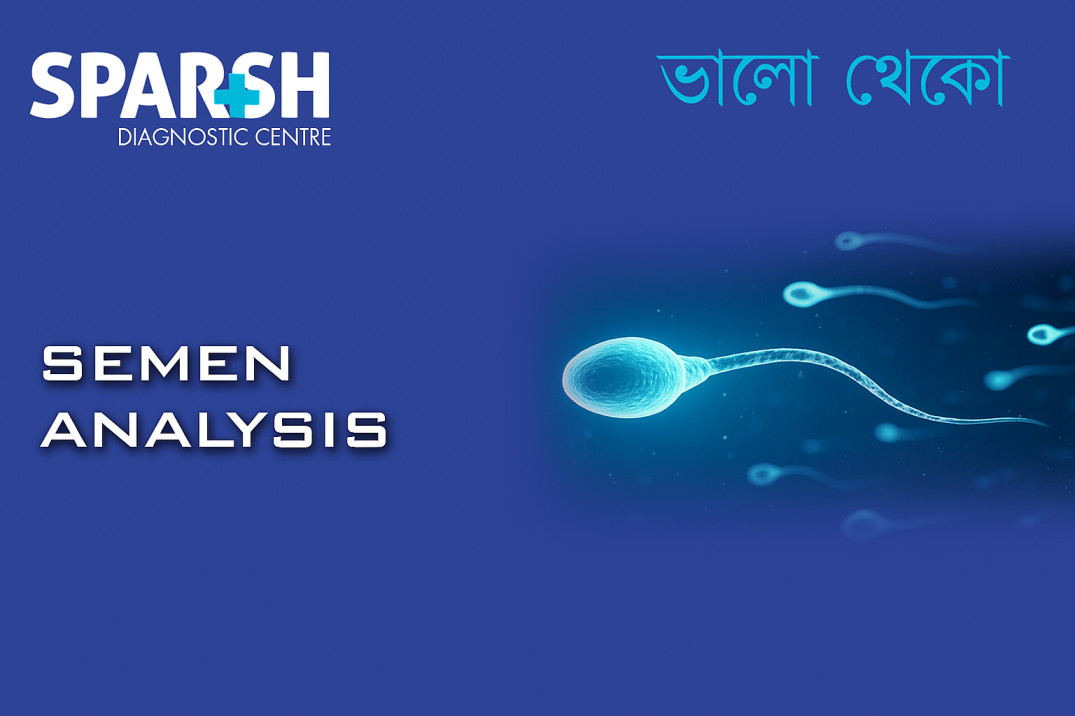Fertility challenges affect millions of couples worldwide, and in about 40–50% of cases, the underlying issue lies with the male partner. One of the most essential diagnostic tools in evaluating male fertility is semen analysis, also known as a sperm count test.
This laboratory test provides critical insights into sperm health, including their number, movement, and shape — all factors that influence a man’s ability to father a child. It’s also a valuable test to monitor the effectiveness of a vasectomy or to evaluate the results of infertility treatments.
In this detailed guide, we’ll discuss what semen analysis is, how it’s done, what the results mean, and what steps to take if the results are abnormal.
What Is Semen Analysis?
Semen analysis is a laboratory examination of a man’s ejaculate to assess various parameters that determine sperm quality and overall reproductive potential.
It evaluates multiple factors, such as:
Semen volume (the amount of ejaculate)
Sperm concentration (sperm count per milliliter)
Motility (movement)
Morphology (shape and structure)
pH level
Presence of white blood cells or abnormal cells
This test provides vital information to determine whether sperm are healthy and capable of fertilizing an egg.
Why Is Semen Analysis Done?
Semen analysis is usually ordered for one or more of the following reasons:
1. Infertility Evaluation
If a couple has been trying to conceive for a year or longer without success, semen analysis helps determine if male infertility is a factor. It provides a clear picture of sperm health and function.
2. Post-Vasectomy Confirmation
After a vasectomy, semen analysis checks for the absence of sperm to confirm the success of the procedure. A follow-up test is typically done a few months post-surgery.
3. Vasectomy Reversal
If a man undergoes a vasectomy reversal, semen analysis helps assess whether sperm are once again present in the ejaculate.
4. Assessment of Reproductive Health
Men with hormonal issues, testicular trauma, or infections may need semen analysis to evaluate how these conditions affect sperm production and quality.
How to Prepare for a Semen Analysis
Proper preparation ensures accurate results. Here are some common pre-test guidelines:
Abstain from ejaculation for 2–7 days before the test.
This helps ensure sperm concentration is at an optimal level.
Avoid alcohol, caffeine, and tobacco for several days before the test.
These substances can temporarily affect sperm motility and count.
Inform your doctor about medications you are taking.
Certain drugs, such as testosterone therapy, antibiotics, or chemotherapy agents, can impact sperm health.
Avoid heat exposure (like hot tubs or saunas) for at least a week before testing.
Heat can lower sperm count and affect motility.
How Is Semen Analysis Done?
Step 1: Sample Collection
The semen sample is collected either through masturbation or by using a sterile condom during intercourse (if masturbation is uncomfortable).
Key points during collection:
The sample is usually collected at the laboratory or fertility center.
It must be kept at body temperature and delivered to the lab within 30–60 minutes if collected at home.
The container should be clean, sterile, and labeled properly.
Step 2: Laboratory Analysis
Once received, the sample undergoes a detailed microscopic and chemical examination. The process generally includes:
Macroscopic Analysis
Volume: Normal volume is between 1.5–6 milliliters.
Color: Typically grayish-white.
Viscosity: Should liquefy within 20–30 minutes after ejaculation.
pH: Normally between 7.2 and 8.0.
Microscopic Analysis
Sperm Concentration: Measures the number of sperm per milliliter.
Motility: Checks what percentage of sperm are moving and how well.
Morphology: Evaluates the shape of sperm (head, midpiece, tail).
Vitality Test: Determines the percentage of live sperm.
White Blood Cells: Indicates potential infection if elevated.
Understanding Semen Analysis Results
Your semen analysis report provides a detailed breakdown of various sperm parameters. Below are standard reference ranges as per the World Health Organization (WHO 2021) guidelines:
| Parameter | Normal Range |
|---|---|
| Volume | ≥ 1.5 mL |
| Sperm Concentration | ≥ 15 million/mL |
| Total Sperm Count | ≥ 39 million per ejaculate |
| Motility (Progressive) | ≥ 32% |
| Total Motility | ≥ 40% |
| Vitality (Live Sperm) | ≥ 58% |
| Morphology (Normal Forms) | ≥ 4% |
| pH | 7.2–8.0 |
Interpreting Abnormal Results
An abnormal semen analysis doesn’t necessarily mean infertility. It indicates that one or more sperm parameters are outside the normal range.
Let’s look at some common findings and their possible implications:
1. Oligospermia (Low Sperm Count)
Meaning: Sperm concentration below 15 million/mL.
Possible Causes: Hormonal imbalance, varicocele, infection, genetic conditions, excessive heat exposure, or drug use.
2. Azoospermia (No Sperm Present)
Meaning: Complete absence of sperm in semen.
Causes: Blockage in the reproductive tract, testicular failure, or hormonal issues.
3. Asthenozoospermia (Poor Motility)
Meaning: Fewer than 40% of sperm show movement.
Causes: Infection, oxidative stress, or lifestyle factors like smoking and alcohol use.
4. Teratozoospermia (Abnormal Morphology)
Meaning: Less than 4% of sperm have a normal shape.
Causes: Exposure to toxins, high temperature, or genetic defects.
5. Hypospermia (Low Semen Volume)
Meaning: Ejaculate volume below 1.5 mL.
Causes: Partial blockage, retrograde ejaculation, or insufficient sample collection.
6. Leukocytospermia (White Blood Cells in Semen)
Meaning: High WBC count, often a sign of infection or inflammation.
Causes of Abnormal Semen Parameters
Several factors can influence sperm health, including:
Lifestyle habits: Smoking, alcohol, obesity, stress, and lack of exercise.
Medical conditions: Varicocele, infections (like STIs), hormonal imbalance, or undescended testes.
Environmental factors: Exposure to chemicals, radiation, or excessive heat.
Medications: Certain antibiotics, anabolic steroids, and chemotherapy drugs.
Age: Sperm quality tends to decline with age.
Treatment and Management Options
Treatment depends on the underlying cause of the abnormal findings:
1. Lifestyle Modifications
Maintain a healthy weight.
Eat a balanced diet rich in antioxidants, zinc, vitamin C, and selenium.
Manage stress and get adequate sleep.
2. Medical Treatments
Hormone therapy for hormonal imbalances.
Antibiotics for infections.
Surgery (e.g., varicocelectomy) to correct varicoceles or obstructions.
3. Assisted Reproductive Techniques (ART)
If natural conception isn’t possible, reproductive technologies can help:
Intrauterine insemination (IUI): Washed sperm are placed directly in the uterus.
In vitro fertilization (IVF): Eggs are fertilized outside the body using the sperm sample.
Intracytoplasmic sperm injection (ICSI): A single healthy sperm is injected directly into an egg.
How Accurate Is Semen Analysis?
Semen analysis is highly informative but can vary from one sample to another due to daily changes in sperm production. That’s why doctors often recommend two or three tests spaced a few weeks apart to get an accurate assessment.
When to See a Doctor
You should consult a healthcare professional or fertility specialist if:
You’ve been trying to conceive for over a year without success.
You have a history of testicular injury, hormonal disorders, or genetic conditions.
You have low libido, erectile dysfunction, or other sexual health issues.
You’ve had radiation, chemotherapy, or urological surgeries in the past.
Possible Complications and Emotional Impact
While semen analysis itself poses no physical risks, abnormal results can lead to emotional distress or anxiety. It’s essential to discuss the findings openly with a healthcare provider, who can guide you on next steps and reassure you about available treatments.
Prevention Tips for Healthy Sperm
Avoid tight clothing and prolonged sitting to reduce scrotal heat.
Eat fertility-boosting foods: walnuts, leafy greens, eggs, and citrus fruits.
Limit exposure to toxins: pesticides, plastics (BPA), and heavy metals.
Stay hydrated and maintain a healthy BMI.
Exercise regularly, but avoid overtraining.
Get regular check-ups to monitor hormonal and reproductive health.
Semen analysis is an essential, non-invasive, and informative test for evaluating male fertility and reproductive health. Whether you’re planning a family, undergoing infertility evaluation, or checking post-vasectomy results, this test offers valuable insights into sperm quality and function.
If abnormalities are detected, modern medicine offers several treatment options — from lifestyle changes and medications to assisted reproductive techniques — ensuring that many men with fertility issues can still achieve successful conception.
For reliable semen analysis and fertility testing, visit Sparsh Diagnostic Centre for expert evaluation and guidance.
Frequently Asked Questions (FAQ)
1. What is the best time to do a semen analysis?
You should abstain from ejaculation for 2–7 days before the test for accurate results. The test can be done any time of day, but the sample should reach the lab within 60 minutes of collection.
2. How many semen samples are needed for an accurate result?
Usually, two to three samples taken over several weeks are recommended to account for natural variations in sperm production.
3. Can stress affect semen analysis results?
Yes, stress can lower testosterone levels and affect sperm count and motility, potentially impacting the results.
4. Does diet influence sperm quality?
Absolutely. A balanced diet rich in antioxidants, vitamins, and minerals supports sperm health and improves fertility potential.
5. Can abnormal results be improved?
Yes, in many cases. Lifestyle changes, medical treatments, and assisted reproductive technologies can significantly improve sperm quality and fertility outcomes.
6. How long does it take to get semen analysis results?
Typically, results are available within 24 to 48 hours after the sample is submitted.
7. Is semen analysis painful?
No, semen analysis is a simple and painless test involving sample collection through ejaculation.
For accurate semen analysis and fertility evaluation, book your appointment today at Sparsh Diagnostic Centre.
#BhaloTheko
Disclaimer:
No content on this site, regardless of date, should ever be used as a substitute for direct medical advice from your doctor or other qualified clinician.

![]()






[…] 4. Semen Analysis […]
[…] Semen Analysis (for men) […]
[…] 3. Semen Analysis […]